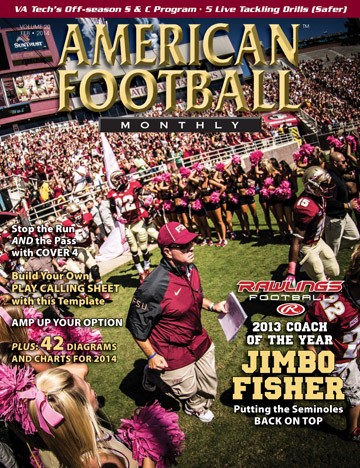Option Football - Few Plays, Many Ways, Part I
by: Paul MarkowskiAssistant Coach, Army Sprint Football, and Shane Ziats, Assistant Coach, Mansfield University ©
More from this issue
Option football has been around for many decades. The vast majority of today’s collegiate and high school programs use some form of option in their offensive scheme.
Why run the option? Football is a “numbers game” where the offense tries to outnumber the defense at the point of attack. While there are more than a few ways to accomplish this goal, we believe that the option is by far the easiest and most effective way to ensure that your offense outnumbers the defense on every play.
KISS PRINCIPLE
The acronym KISS means “Keep It Simple Stupid”. We are true believers in the KISS principle. This is especially important at the high school level as these programs are severely handicapped in how much time they have to practice and install their offensive and defensive schemes. Keeping the offensive playbook as simple as possible is a must.
MASTER A FEW PLAYS
In order for any offense to be effective, we believe that players must master a few plays and run those plays with both confidence and efficiency. Those few plays must be repped to the extent that your players “know” the plays inside and out. Performing a large number of plays relatively well will not help your offense when crunch-time hits late in the fourth quarter and you need to move the football consistently for that final score. Players who truly know a play will perform that play with both confidence and aggressiveness. If there is any doubt in their minds about their particular assignment on a play, they will not perform to the best of their ability.
FEW PLAYS, MANY WAYS
This offense is an attempt to take option football to a brand new level. Our playbook is very simple: six run plays and six pass plays. That’s it. We believe that any high school program can master these twelve plays even with limited practice and installation time. The goal of our playbook is simple: to master these twelve plays and run them “many” different ways. By doing this, we believe it will cause confusion for the defense. For example, when your opponent sees you line up in the wishbone and run triple option on one play and then line up in Power-I and run the same play, to the defense, these two plays may look very different. In reality, however, your offensive players are simply running the same play from a different “look”. It’s truly that simple.
THE FORMATIONS
The four formations we use in this option offense are the Wishbone, Pistol-Flex, Flexbone and the Power-I. We chose these four sets because we feel that they are what most run-oriented high school programs will be using. All four formations are basic, easy to learn, and very powerful offensive sets.
Wishbone - The wishbone formation has been around since the 1960s and has enjoyed much success over the years at all levels. While this three-back set allows for a very strong run-oriented scheme, the two wide receivers who are spread very wide will force the defense to spread themselves out a little as well. One huge advantage of having the three-back set aligned so tight is that there will be no need to use any type of pre-snap motions in order to get a player into position. Motion can tip off any defense as to the possible point of attack of the play call.
Pistol-Flex - The pistol-flex is a hybrid of the pistol and flexbone offensive sets. One of the main advantages of the pistol-flex formation is the alignment of the QB, who is four yards directly behind the center. By having him aligned in this way, the QB will have a better read of the dive key defender since the QB will be physically further away from the read key. The QB will not have a “longer” read, but he will have a better angle from which to make a more proficient read.
Flexbone - Flexbone is similar to the pistol-flex. The only difference is the alignment of the QB. In flexbone, he is under center while in the pistol-flex, the QB is at pistol depth.
Unlike the wishbone, the flexbone places the two halfbacks (A-Backs) in the slot area on either side of the formation. Having these players wide may necessitate the QB having to get one of them into orbit motion for a couple of the option plays in order for the player to get into his proper alignment at the snap of the ball. Motion may tip off the defense as to the play’s destination. However, on a more positive note, having motion may fool the defense into thinking the play is going one way when in fact, it ends up going the opposite direction (e.g., the counter option).
Power-I - The power-I formation is an offshoot of the wishbone formation. Power-I is your basic I-formation with an extra blocking back added for a stronger running game.
RUN PLAYS
The six run plays that we chose for this offense were selected for very specific reasons. Triple option football is not just a concept; rather, it is a “system” of run and pass plays that, depending on what the defense is showing, allows us to call the right play in order to counter what the defense is trying to accomplish. Because this offense is very run-oriented, these six run plays must take up no less than 75% of your practice time. The remaining 25% will be devoted to the passing concepts.
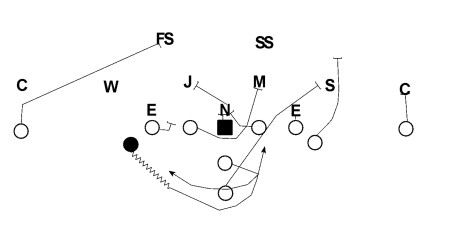
1) Triple Option
This is our base, bread and butter play. It is actually three plays in one. Every play in the option system feeds off of the success of this one play. Triple option must be repped repeatedly each practice so that it can be mastered.
Execution: Prior to the snap of the ball, the QB must identify both the dive (#1) and pitch (#2) defenders. These two players will not be blocked. Instead, the QB will “read” these defenders’ intentions during the execution of the play and react according to what they do. The dive key is defined as the “first player on or outside the playside offensive tackle”. The pitch key is defined as the “next defensive player outside of the dive key”.
Once these players have been identified, the QB calls for the ball. After the snap, the QB goes into a “mesh” (soft squeeze) with the diving running back. The QB puts the ball into the gut of the running back while he reads the dive key. We give the QB a “one-way thought process” as to how he reads the dive key. By doing this, it will make it much easier for the QB to make a decisive decision. We tell him to think, “I will give the football every time to that diving running back unless the Dive key comes down both hard and flat onto the running back”.
So, the QB will be thinking pre-snap that he will give that ball to the dive back unless the dive key virtually attacks the running back immediately. If the dive key does not take the running back, then the ball carrier should take the handoff and attack his aiming point – the crack of the playside offensive guard’s butt. In addition, it is very important that the dive back read his AK (Action Key). The AK defender is defined as the first defensive lineman inside of the dive key defender. Depending on how this AK is blocked, it will determine the path of the dive back. However, if that dive key does take the running back, the QB simply disengages the mesh with the running back and proceeds to attack the pitch key.
Once again, we give the QB a one-way thought process. We tell him to think, “I will keep the ball every time and score a touchdown unless the pitch key turns his outside shoulder toward me”. If the pitch key does take the QB, he simply steps, looks at his target (pitch back) and pitches the ball to him.
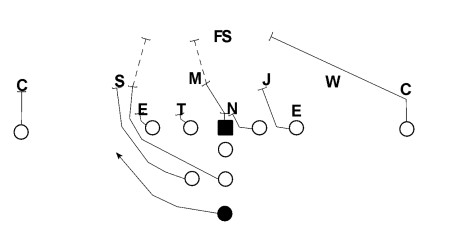
2) Midline Option
Midline is a double option with the QB/dive back. Many option teams who do not like to/or cannot block a very tough 3-tech defensive tackle in a triple option play call will check to midline so that the 3-tech can now be “read” by the QB.
Execution: Like with the triple option play, the QB must find his read keys prior to the snap of the ball. For midline option, there is only a dive key defender to identify. The dive key is defined as the “first defensive lineman on or outside the playside offensive guard”. After the snap, the QB and dive back go into their “mesh” and depending on how the dive key plays his assignment, the QB will either give the ball to the dive back or pull it and “replace the read”. What we mean by this is simple - if there is a disengage between the QB and the running back, then the QB attacks the original spot of the dive key defender. The aiming point of the dive back is the crack of the center’s butt.
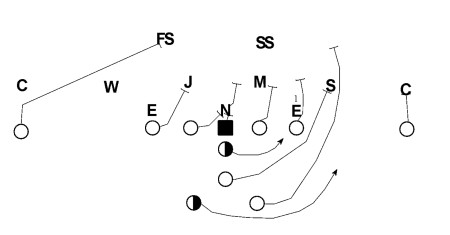
3) Counter Option
The counter option play is a very important cog in the option system wheel. Sometimes during the course of a game, the defense may start to “key” on certain tendencies that the offense might be displaying with the option run game (e.g., keying on motion, hash marks, down and distance, etc.). As a result, the defense may start flowing very fast to the perceived point of attack in order to pounce on the play as soon as possible. This counter option is a great complementary play to the triple option. When the defense starts to “cheat” a little by sending their backside linebacker towards the perceived point of attack, it is time to call the counter option. Not only will this play gouge the defense for some big yardage, it will also force the defense to play more honest.
Execution: It is extremely important that this play “looks” like the base triple option. Once the defense commits to stopping this perceived triple option play, our goal has been accomplished and we now reverse direction and attack the back side. Prior to the snap, the QB must identify the pitch key defender. The pitch key is defined as the “next defensive player outside of the end man on the line of scrimmage (EMOLOS)”.
After the snap, the play appears to be a true triple option play. However, after selling this fake for one step, the backfield will then reverse field and attack the opposite side. The QB performs a very quick “mesh” with his dive back and then immediately turns and attacks his pitch key. Depending on how this defender executes his assignment, the QB will either run the ball upfield or pitch to his trailing pitch back.
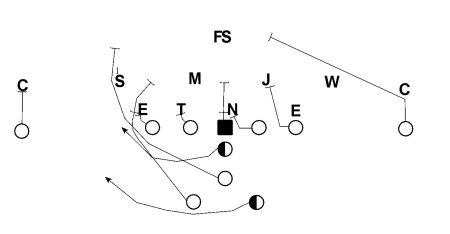
4) Speed (Double) Option
This play allows our offense to get to the perimeter quickly. Speed option and double option are the very same play with one important exception – the identity of the Pitch Key defender. In speed option, the QB reads the EMOLOS while in double option, the QB will read the “next defensive player outside of the EMOLOS”. Whether speed or double Option is called will depend on what your scouting reports indicate. Some coaches prefer to block certain defenders and read others. If a certain defender is particularly tough to block, than the coaching staff might decide to read that player and block someone else. For example, defensive ends are usually some of the best athletes on any team. That said, an offensive coordinator may decide to “read” this best player and block the outside linebacker or, if that outside linebacker is the best defender, than he might end up being the read defender while that defensive end is blocked. It is all a matter of preference.
Execution: Once again, this play must appear to be our base triple option play at the snap of the ball. The QB must identify the pitch key defender. After the snap, the QB will immediately attack his pitch key and depending on how he plays him, will either keep the ball and get upfield or pitch it to his trailing pitch back. The pitch back must maintain a 4 x 1 pitch relationship with the QB at all times; that is, he must be 4 yards in front of and 1 yard deep in relation to his QB.
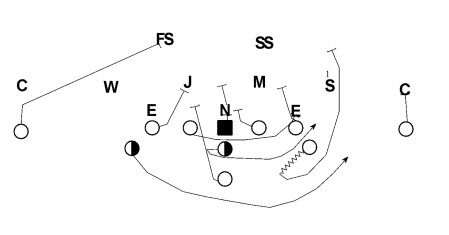
5) Toss
Our toss play is used when we notice that our opponents are blitzing more than usual. Toss allows us to get to the edge very quickly in order to beat the blitz coming up between the tackles. Toss is a great complementary play to call when you are on or very close to your opponent’s goal line.
Execution: This play will appear to be our base triple option play at the snap. The QB reverse pivots and tosses the ball to his pitch back. This play is very similar to the outside zone play. All linemen step very wide and block the first man. This play is meant to get to the outside. The ball carrier is taught to get to the outside and look for any seam that appears. Once that seam appears, he is to stick his toe into the ground and get upfield.
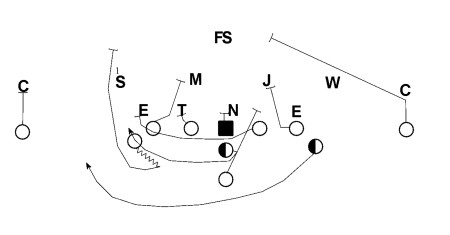
6) Power
This base power play is common with many offensive schemes in today’s game. Power is meant to hit the defense between the offensive tackles.
Execution: The ball carrier must be taught to keep his track between the tackles. He is to bounce this play to the outside only when there is no daylight to run to on the inside.
Six different diagrams will illustrate some of these formations and assignments:
About the Authors: Paul Markowski is the running backs coach at the United States Military Academy for Sprint football. He previously coached at both Mansfield University and Simon Fraser. Markowski recently completed a series of DVDs on the Pistol-Flex Triple Option offense that is available at AFMvideos.com
Shane Ziats is the offensive line coach and run game coordinator for Mansfield University. He coached at the high school level for six years and played as an offensive lineman for California University (PA).
This excerpt was taken with permission from the authors of “Option Football: Few Plays, Many Ways”. For more information about this manual, contact Coach Markowski at Paul Markowski2009@gmail.com.
